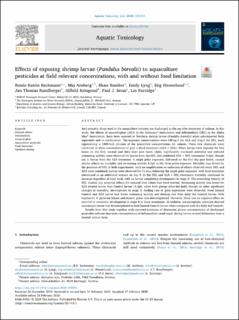| dc.description.abstract | Anti-parasitic drugs used in the aquaculture industry are discharged to the sea after treatment of salmon. In this study, the effects of azamethiphos (AZA) in the Salmosan® formulation and deltamethrin (DEL) in the Alpha Max® formulation, have been assessed in Northern shrimp larvae (Pandalus borealis) when administered both separately and in combination. The exposure concentrations were 100 ng/L for AZA and 2 ng/L for DEL, each representing a 1000-fold dilution of the prescribed concentrations for salmon. These two chemicals were combined at these concentrations to give a third treatment (AZA + DEL). When larvae were exposed for two hours on the first, second and third days post hatch (dph), significantly increased mortality and reduced swimming activity were observed for larvae from the DEL and combined AZA + DEL treatments 4 dph, though not in larvae from the AZA treatment. A single pulse exposure, delivered on the first day post hatch, caused similar effects on mortality and swimming activity 4 dph as the three-pulse exposure. Mortality was driven by the presence of DEL in both experiments, with no amplification or reduction of effects observed when DEL and AZA were combined. Larvae were observed for 13 days following the single pulse exposure, with food limitation introduced as an additional stressor on day 4. In the DEL and AZA + DEL treatments mortality continued to increase regardless of food level, with no larvae completing development to stage II. The overriding toxicity of DEL masked any potential effects the reduced food ration may have exerted. Swimming activity was lower for AZA treated larvae than Control larvae 13 dph, when both groups were fed daily, though no other significant changes to mortality, development to stage II, feeding rate or gene expression were observed. Food limited Control and AZA larvae had lower swimming activity and feeding rate than daily fed Control larvae, with expression of pyruvate kinase and myosin genes also downregulated. However, there was no negative effect on survival or successful development to stage II in these treatments. In addition, mesencephalic astrocyte-derived neurotropic factor was downregulated in food limited Control larvae when compared with the daily fed Controls. Results from this study together with reported estimates of dispersion plume concentrations of discharged pesticides indicate that toxic concentrations of deltamethrin could reach shrimp larvae several kilometers from a treated salmon farm. | |

